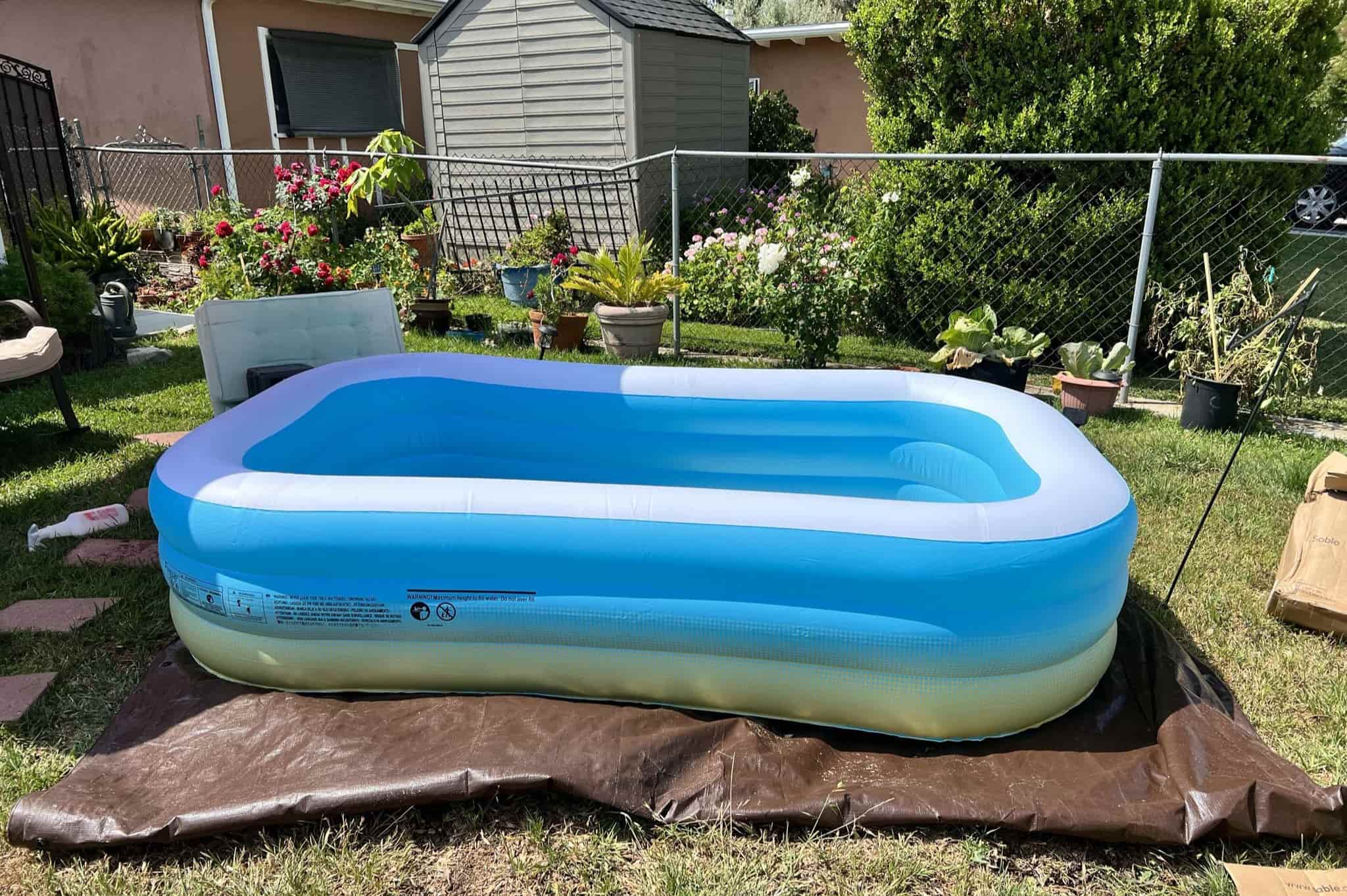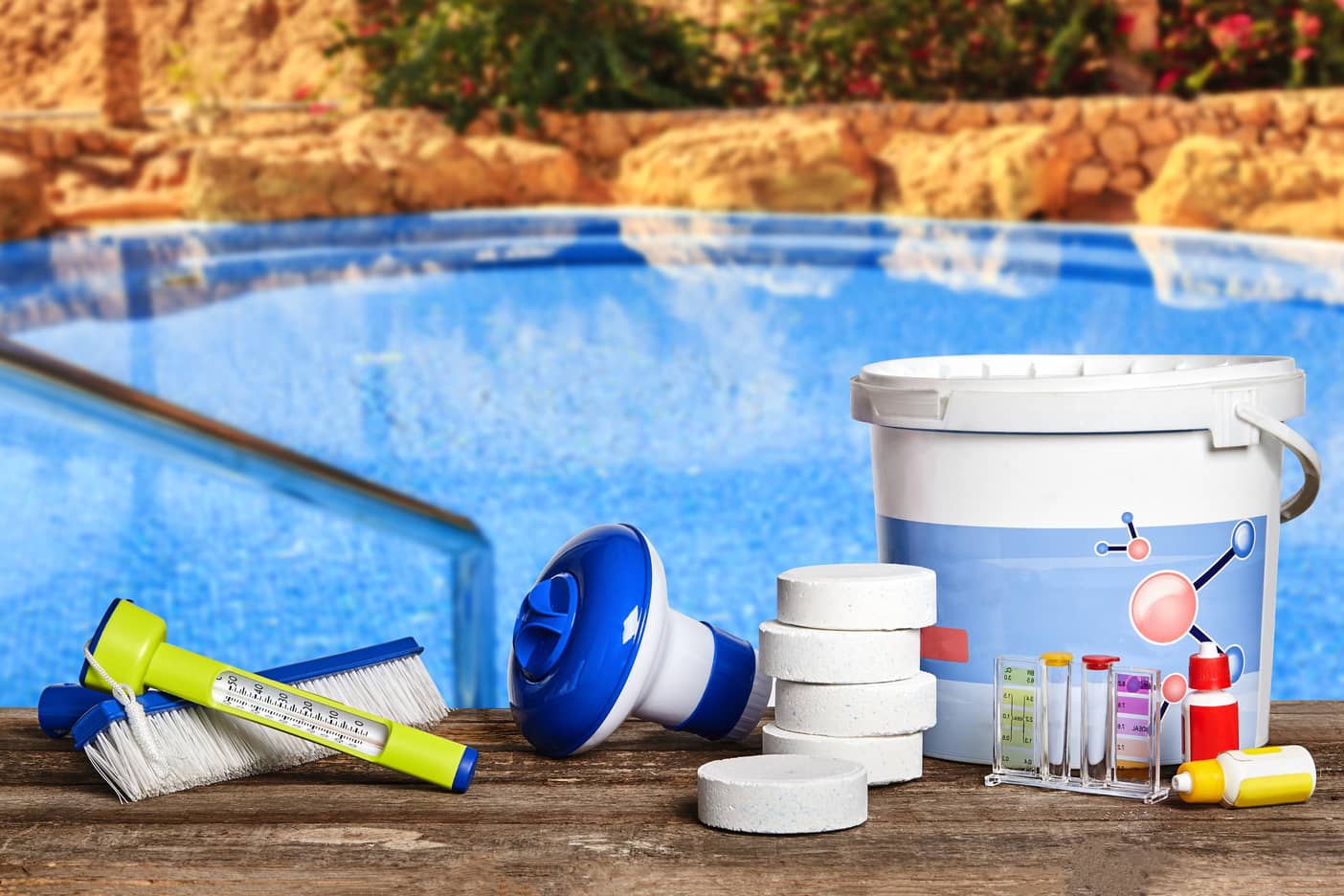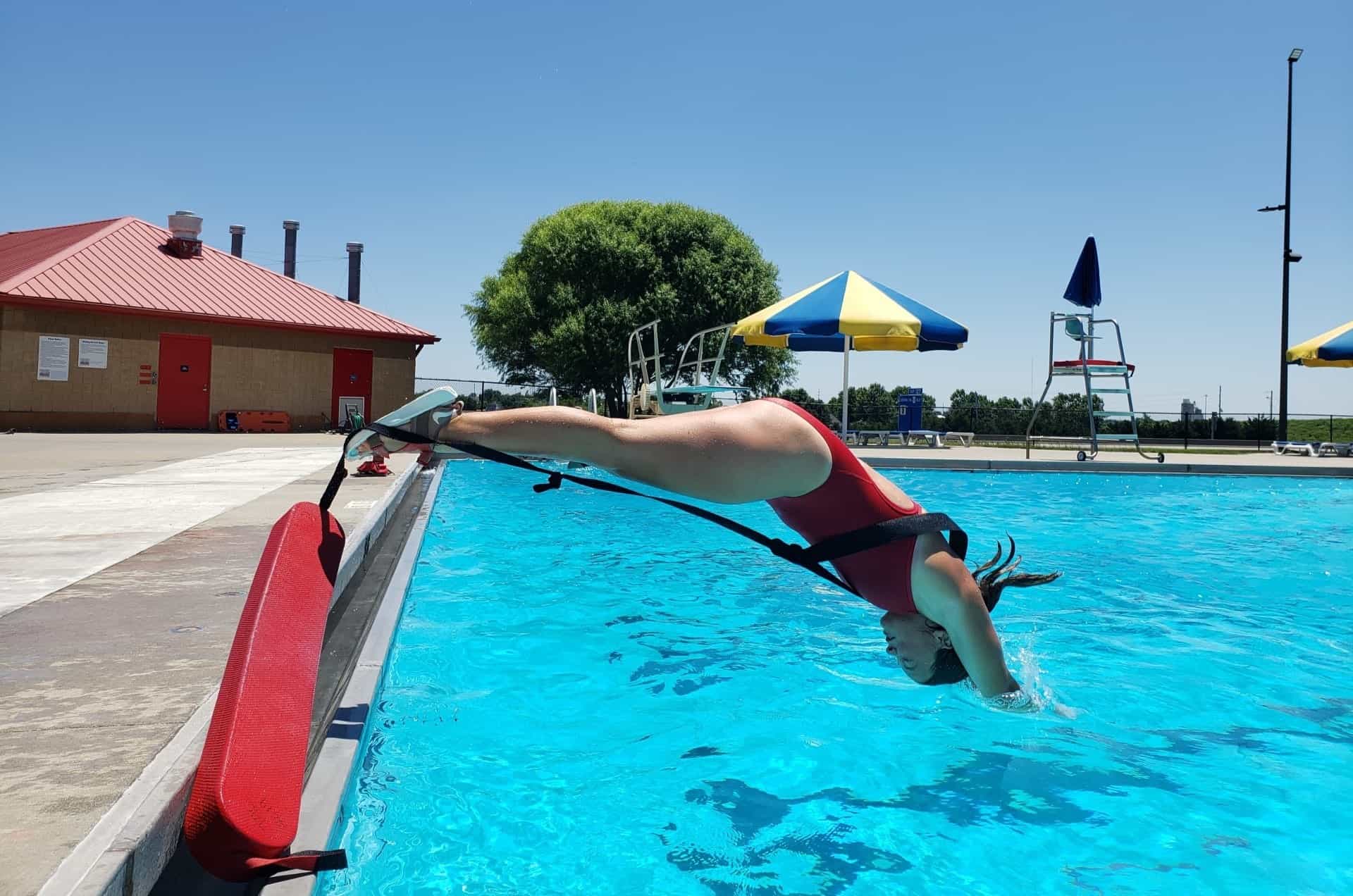Home>Gardening & Outdoor>Outdoor Recreation & Activities>How To Cover A Swimming Pool


Outdoor Recreation & Activities
How To Cover A Swimming Pool
Published: February 18, 2024
Learn how to cover your swimming pool for outdoor recreation and activities. Discover the best methods and materials for protecting your pool from the elements.
(Many of the links in this article redirect to a specific reviewed product. Your purchase of these products through affiliate links helps to generate commission for Storables.com, at no extra cost. Learn more)
Introduction
Covering a swimming pool is an essential aspect of pool maintenance, offering numerous benefits that contribute to the pool's longevity and cleanliness. Whether you're preparing for the winter season, going on an extended vacation, or simply looking to keep your pool pristine between uses, a well-fitted cover is a valuable investment. By shielding the pool from debris, minimizing water evaporation, and preventing the growth of algae, a cover not only reduces maintenance efforts but also promotes a safer and more enjoyable swimming experience.
In this comprehensive guide, we will walk you through the step-by-step process of covering your swimming pool effectively. From gathering the necessary materials to selecting the right cover and ensuring its proper installation, each stage plays a crucial role in safeguarding your pool and maximizing its lifespan. By following these instructions, you can maintain a clean and inviting pool environment while minimizing the need for extensive cleaning and maintenance.
Properly covering your swimming pool also has environmental benefits, as it helps conserve water by reducing evaporation. This is particularly important in regions experiencing water scarcity or during periods of drought. Additionally, a securely covered pool can enhance safety by preventing accidental falls and minimizing the risk of unauthorized access, especially in households with children or pets.
As we delve into the intricacies of covering a swimming pool, it's important to note that different types of covers are available, each catering to specific needs and preferences. Whether you opt for a solar cover to harness the sun's energy for heating, a mesh cover for debris protection, or a solid cover for maximum cleanliness, understanding the unique features of each option is crucial for making an informed decision.
By the end of this guide, you will have gained valuable insights into the best practices for covering your swimming pool, empowering you to maintain a pristine and well-protected pool environment throughout the year. Let's embark on this journey to discover the art of covering a swimming pool effectively and efficiently.
Key Takeaways:
- Covering your swimming pool not only keeps it clean but also conserves water and enhances safety. By following the steps in this guide, you can maintain a pristine pool environment with minimal effort.
- Choosing the right cover, installing it properly, and maintaining it regularly are essential for protecting your pool. With the right approach, you can enjoy a clean, safe, and well-protected swimming experience.
Step 1: Gather the necessary materials
Before embarking on the process of covering your swimming pool, it's essential to gather all the necessary materials to ensure a smooth and efficient experience. Having the right tools and equipment at your disposal will not only streamline the process but also contribute to the overall effectiveness of the pool cover. Here's a comprehensive list of the essential materials you'll need:
-
Pool Cover: The first and most crucial item on your list is the pool cover itself. Depending on your specific requirements and preferences, you can choose from various options such as solar covers for heat retention, mesh covers for debris protection, or solid covers for maximum cleanliness. Ensure that the cover is of the appropriate size to fit your pool dimensions accurately.
-
Measuring Tape: Accurately measuring your pool's dimensions is vital for selecting the right cover. A reliable measuring tape will enable you to determine the length, width, and shape of your pool, ensuring that the cover fits perfectly.
-
Pool Cover Pump: If you live in an area prone to heavy rainfall or snow, a pool cover pump is indispensable for preventing water accumulation on the cover. This device helps maintain the integrity of the cover and prevents damage caused by excessive weight.
-
Broom or Leaf Blower: Clearing the pool area of debris and leaves is essential before covering the pool. A broom or leaf blower will come in handy for tidying up the surroundings, ensuring that no unwanted particles end up in the pool when the cover is in place.
-
Anchors or Weights: Depending on the type of cover you choose, you may need anchors or weights to secure the cover in place. These ensure that the cover remains taut and stable, providing maximum protection for your pool.
-
Cleaning Supplies: Before covering the pool, it's advisable to give it a thorough cleaning to minimize the accumulation of dirt and debris. Gather your pool cleaning supplies, including a pool brush, skimmer, and pool vacuum, to ensure that the water is pristine before covering it.
By ensuring that you have all these materials at your disposal, you can proceed to the next steps of the pool covering process with confidence and efficiency. Each item plays a crucial role in safeguarding your pool and ensuring that the cover is installed effectively, setting the stage for a clean and well-protected swimming environment.
Step 2: Clean the pool
Before covering your swimming pool, it's essential to ensure that the pool is thoroughly cleaned to minimize the accumulation of dirt, debris, and contaminants. A clean pool not only promotes better water quality but also prevents the potential for algae growth and staining, contributing to a more hygienic and visually appealing swimming environment. Here's a detailed breakdown of the cleaning process to prepare your pool for covering:
Skim and Remove Debris
Using a pool skimmer, carefully skim the surface of the water to remove any leaves, insects, or other floating debris. This initial step helps prevent these particles from settling to the bottom of the pool, making the cleaning process more manageable.
Brush the Walls and Tiles
Utilize a pool brush to scrub the walls and tiles of the pool, focusing on areas where algae and grime may have accumulated. By thoroughly brushing these surfaces, you can dislodge any stubborn debris and prevent the formation of unsightly stains, ensuring that the pool's interior remains clean and inviting.
Read more: How To Clean A Swimming Pool
Vacuum the Pool
Employ a pool vacuum to eliminate dirt and sediment that may have settled on the pool floor. Ensure thorough coverage of the entire pool surface, paying particular attention to corners and crevices where debris tends to accumulate. By effectively vacuuming the pool, you can maintain pristine water clarity and prevent the buildup of contaminants.
Check and Clean the Filter
Inspect the pool's filtration system and clean or replace the filter as needed. A clean and efficient filter is crucial for removing impurities from the water, ensuring optimal circulation, and maintaining water clarity. Regular filter maintenance is essential for the overall cleanliness and health of the pool.
Test and Balance the Water Chemistry
Utilize a pool water testing kit to assess the chemical balance of the water, including pH levels, alkalinity, and chlorine concentration. Adjust the chemical levels as necessary to ensure that the water is balanced and safe for swimming. Proper water chemistry not only enhances water clarity but also protects the pool equipment and promotes a comfortable swimming experience.
By meticulously cleaning the pool and addressing water quality concerns, you can create an optimal foundation for covering the pool effectively. This proactive approach not only contributes to the longevity of the pool cover but also minimizes the need for extensive cleaning and maintenance in the future. With a clean and well-maintained pool, you can proceed to the next steps of the covering process with confidence, knowing that your pool is adequately prepared for protection and preservation.
Step 3: Measure the pool dimensions
Accurately measuring the dimensions of your swimming pool is a critical preparatory step before selecting and installing a pool cover. By obtaining precise measurements, you can ensure that the cover fits snugly and provides optimal protection for your pool. Here's a detailed guide on how to measure your pool's dimensions effectively:
-
Use a Measuring Tape: Begin by using a reliable measuring tape to determine the length and width of your pool. Measure from the outer edges of the pool to obtain the most accurate dimensions. If your pool has an irregular shape, such as a kidney or freeform design, take multiple measurements to capture the overall size and shape comprehensively.
-
Account for Overhang: When measuring for a pool cover, it's essential to consider any overhang or coping around the pool's perimeter. The cover should extend beyond the water's edge to ensure complete coverage and protection. Measure the distance from the waterline to the outer edge of the coping to determine the required cover size accurately.
-
Note the Shape and Features: Take note of any unique features or obstructions within the pool area, such as steps, ladders, or raised spa sections. These elements may require custom fitting or additional considerations when selecting a cover. Measure the dimensions of these features and factor them into your overall pool measurements.
-
Consider the Type of Cover: Depending on the type of pool cover you choose, such as a solar cover, mesh cover, or solid cover, the measuring process may vary. For instance, a solar cover may require precise measurements to accommodate the reel system, while a mesh cover may need additional allowances for anchoring and tensioning.
-
Double-Check the Measurements: After obtaining the initial measurements, double-check all dimensions to ensure accuracy. Small discrepancies in measurements can lead to ill-fitting covers, compromising their effectiveness. Taking the time to verify the measurements can prevent potential issues during the installation phase.
By meticulously measuring the dimensions of your swimming pool and accounting for specific features and requirements, you can proceed to the next steps of the covering process with confidence. These precise measurements will guide you in selecting the right cover and ensuring a seamless installation, ultimately contributing to the long-term protection and maintenance of your pool.
Read more: How To Tile A Swimming Pool
Step 4: Choose the right cover
Selecting the appropriate cover for your swimming pool is a pivotal decision that directly influences the level of protection, maintenance requirements, and overall functionality of the cover. With various options available, each catering to specific needs and preferences, it's essential to consider key factors that align with your pool's characteristics and your desired outcomes. Here's a comprehensive guide to help you choose the right cover for your swimming pool:
Consider Pool Size and Shape
Begin by assessing the size and shape of your pool, as these factors play a crucial role in determining the most suitable cover. Rectangular pools may align well with traditional solid covers, while freeform or irregularly shaped pools may require custom-fitted covers to ensure comprehensive protection. Additionally, consider any unique features such as attached spas, raised walls, or integrated water features, as these elements may influence the cover selection process.
Evaluate Environmental Factors
Take into account the environmental conditions surrounding your pool area, including prevailing weather patterns, foliage density, and potential debris sources. If your pool is susceptible to heavy leaf fall or airborne debris, a mesh cover may be the ideal choice, offering effective debris protection while allowing water to pass through. In contrast, if you seek to harness solar energy for pool heating and minimize water evaporation, a solar cover with insulating properties may be the preferred option.
Assess Maintenance Preferences
Consider your maintenance preferences and the level of convenience you seek in managing the pool cover. Solid covers, while providing maximum cleanliness and protection, may require periodic removal for debris removal and maintenance. On the other hand, automatic or retractable covers offer seamless operation and minimal manual effort, making them an attractive choice for those prioritizing convenience. Understanding your maintenance preferences will guide you in selecting a cover that aligns with your lifestyle and upkeep expectations.
Read more: How To Empty A Swimming Pool
Explore Additional Features
Explore the additional features and benefits offered by different types of pool covers. For instance, some covers are designed with safety in mind, featuring reinforced materials and locking mechanisms to prevent unauthorized access and enhance overall security. Others may incorporate UV-resistant properties, prolonging the cover's lifespan and preserving its aesthetic appeal. By evaluating these supplementary features, you can identify a cover that not only meets your primary requirements but also offers added value in terms of safety, durability, and functionality.
Seek Professional Guidance
If you're uncertain about the most suitable cover for your pool, consider seeking guidance from pool maintenance professionals or cover specialists. Their expertise and insights can help you navigate the diverse range of options, understand the technical specifications, and make an informed decision based on your specific needs and preferences. Professional input can provide valuable clarity and ensure that the chosen cover aligns with your pool's unique characteristics and your long-term objectives.
By carefully considering these factors and exploring the diverse range of pool cover options, you can make a well-informed decision that enhances the protection, efficiency, and overall enjoyment of your swimming pool. The right cover not only safeguards your pool from external elements but also contributes to a more sustainable and enjoyable pool ownership experience.
Step 5: Install the cover
Installing the pool cover is a pivotal step in safeguarding your swimming pool and ensuring its long-term protection. Proper installation not only maximizes the cover's effectiveness but also contributes to the overall cleanliness and maintenance of the pool. Here's a detailed guide on how to install the cover effectively, setting the stage for a well-protected and pristine pool environment.
Lay Out the Cover
Begin by unrolling the cover and positioning it over the pool, ensuring that it is centered and aligned with the pool's edges. If the cover features specific markings or labels indicating its orientation, follow these guidelines to ensure proper alignment. Smooth out any wrinkles or folds to achieve a uniform and taut surface, optimizing the cover's functionality and appearance.
Read more: How To Draw A Swimming Pool
Secure the Cover
Depending on the type of cover, secure it in place using the designated fastening mechanisms. For solid covers, utilize water bags or heavy-duty springs to anchor the cover securely. Mesh covers may require the use of anchors and tensioning devices to maintain stability and prevent debris infiltration. Follow the manufacturer's instructions carefully to ensure that the cover is secured effectively, minimizing the risk of displacement or damage.
Address Obstructions
If your pool features unique elements such as steps, ladders, or raised spa sections, take the necessary steps to accommodate these obstructions during the installation process. Custom-fitted covers or supplementary fastening methods may be required to ensure complete coverage and protection. Pay close attention to these areas to prevent potential gaps or vulnerabilities in the cover's integrity.
Trim Excess Material
If the cover exhibits excess material beyond the pool's perimeter, carefully trim it to achieve a neat and tailored fit. Precision trimming not only enhances the cover's aesthetic appeal but also eliminates potential tripping hazards and ensures a streamlined appearance. Exercise caution and use appropriate cutting tools to achieve clean and precise edges.
Verify Tension and Alignment
Once the cover is in place, verify its tension and alignment to confirm that it is securely fastened and free from sagging or slack areas. Tautness is essential for maximizing the cover's effectiveness in preventing debris accumulation and maintaining a barrier against external elements. Regularly inspect the cover's tension to address any adjustments or re-tensioning as needed.
By following these installation steps meticulously, you can ensure that your pool cover is installed with precision and care, providing comprehensive protection and minimizing maintenance requirements. A properly installed cover sets the foundation for a clean, secure, and well-maintained pool environment, allowing you to enjoy the benefits of effective pool coverage throughout the year.
Read more: How Long Is A Swimming Pool
Step 6: Secure the cover
Securing the pool cover is a critical aspect of the covering process, as it directly influences the cover's ability to provide effective protection and maintain the pool's cleanliness. Properly securing the cover not only safeguards the pool from debris and external elements but also enhances safety and minimizes the risk of damage or displacement. Here's a detailed breakdown of the essential steps to ensure the secure installation of your pool cover:
Utilize Designated Fastening Mechanisms
Depending on the type of pool cover you have chosen, utilize the designated fastening mechanisms to secure the cover in place effectively. For solid covers, heavy-duty springs or water bags are commonly used to anchor the cover securely and maintain tension across the surface. These fastening components play a crucial role in preventing the cover from shifting or being dislodged by external forces, ensuring its stability and functionality.
Anchor Points and Tensioning Devices
Mesh covers often require the use of anchor points and tensioning devices to maintain stability and prevent debris infiltration. Anchors are strategically positioned around the pool's perimeter, and the cover is tensioned to achieve a taut and secure fit. This process not only prevents the accumulation of debris on the cover but also minimizes the risk of sagging or slack areas, optimizing the cover's protective capabilities.
Follow Manufacturer's Instructions
Adhere to the manufacturer's instructions and guidelines for securing the specific type of pool cover you have. Manufacturers provide detailed recommendations for the proper installation and fastening of their covers, taking into account factors such as cover material, size, and environmental considerations. By following these instructions meticulously, you can ensure that the cover is secured in a manner that maximizes its effectiveness and longevity.
Read more: How Deep Is A Swimming Pool
Regular Inspections and Adjustments
After securing the cover, conduct regular inspections to verify its stability and tension. Periodically check the fastening mechanisms, anchor points, and tensioning devices to ensure that they remain intact and functional. Address any signs of loosening or displacement promptly, making necessary adjustments to maintain the cover's secure fit and protective integrity.
Consider Additional Safety Measures
In addition to securing the cover itself, consider implementing additional safety measures to enhance protection and prevent unauthorized access. If the pool is located in an area accessible to children or pets, supplementary safety barriers or locking mechanisms can provide an extra layer of security, minimizing the risk of accidental entry and promoting peace of mind.
By meticulously securing the pool cover using the appropriate fastening methods and adhering to manufacturer's guidelines, you can ensure that your pool is effectively shielded from debris, environmental elements, and potential safety hazards. A securely installed cover sets the stage for a clean, well-protected pool environment, allowing you to enjoy the benefits of effective pool coverage with confidence and peace of mind.
Step 7: Maintain the cover
Proper maintenance of the pool cover is essential for preserving its functionality, extending its lifespan, and ensuring ongoing protection for your swimming pool. By implementing regular maintenance practices, you can uphold the cover's integrity, minimize wear and tear, and optimize its performance in safeguarding the pool environment. Here's a comprehensive guide on maintaining the pool cover effectively:
Clean and Inspect Regularly
Regularly clean the pool cover to remove debris, dirt, and any organic matter that may accumulate on its surface. Use a soft brush or gentle cleaning solution to prevent damage to the cover material. Inspect the cover for any signs of wear, tear, or damage, paying close attention to seams, fastening components, and overall structural integrity. Address any issues promptly to prevent them from escalating and compromising the cover's protective capabilities.
Read more: How To Design A Swimming Pool
Remove Standing Water
If the pool cover accumulates standing water due to rainfall or other environmental factors, promptly remove it using a pool cover pump or siphoning method. Standing water adds unnecessary weight and strain to the cover, potentially leading to stretching, tearing, or deformation. Regularly monitoring and removing standing water helps preserve the cover's shape and functionality.
Store Properly When Not in Use
During periods when the pool cover is not in use, store it properly to prevent damage and deterioration. Ensure that the cover is clean, completely dry, and free from any debris before folding or rolling it for storage. Store the cover in a cool, dry area away from direct sunlight and potential sources of abrasion or puncture. Proper storage safeguards the cover from environmental elements and prolongs its usability.
Address Tears and Damage
In the event of tears, punctures, or other forms of damage to the cover, promptly address these issues using appropriate repair methods. Depending on the extent of the damage, patching materials, adhesives, or professional repair services may be necessary. Timely repairs prevent the damage from worsening and maintain the cover's effectiveness in protecting the pool.
Follow Manufacturer's Guidelines
Adhere to the manufacturer's specific maintenance guidelines and recommendations for the pool cover. Manufacturers often provide detailed instructions on cleaning methods, storage procedures, and repair techniques tailored to their cover products. By following these guidelines, you can ensure that the cover receives the care and attention necessary for optimal performance and longevity.
By implementing these maintenance practices, you can uphold the functionality and durability of the pool cover, ensuring that it continues to provide effective protection for your swimming pool. Regular maintenance not only preserves the cover's integrity but also minimizes the need for extensive repairs and replacements, contributing to a sustainable and well-maintained pool environment.
Read more: How To Paint A Swimming Pool
Conclusion
In conclusion, effectively covering a swimming pool is a fundamental aspect of pool maintenance that offers a multitude of benefits, ranging from preserving water quality and minimizing maintenance efforts to enhancing safety and promoting environmental sustainability. Throughout this comprehensive guide, we have explored the step-by-step process of covering a swimming pool, encompassing essential stages such as gathering materials, cleaning the pool, measuring dimensions, selecting the right cover, installation, securing, and ongoing maintenance.
By meticulously following these guidelines, pool owners can ensure that their pool cover serves as a reliable barrier against debris, environmental elements, and potential safety hazards. The proactive approach of cleaning the pool before covering it not only contributes to water clarity but also minimizes the risk of algae growth and staining, creating a more hygienic and visually appealing swimming environment.
Selecting the right cover tailored to the pool's size, shape, environmental factors, and maintenance preferences is crucial for achieving optimal protection and functionality. Whether opting for a solar cover to harness the sun's energy for heating, a mesh cover for debris protection, or a solid cover for maximum cleanliness, understanding the unique features of each option empowers pool owners to make informed decisions aligned with their specific needs and preferences.
The installation and secure fastening of the cover play a pivotal role in safeguarding the pool and ensuring its long-term protection. By following the recommended installation steps and adhering to manufacturer's guidelines, pool owners can establish a clean, secure, and well-maintained pool environment, allowing them to enjoy the benefits of effective pool coverage with confidence and peace of mind.
Furthermore, ongoing maintenance practices, including regular cleaning, proper storage, and timely repairs, are essential for preserving the cover's functionality, extending its lifespan, and optimizing its performance in safeguarding the pool environment. By implementing these maintenance practices, pool owners can uphold the cover's integrity, minimize wear and tear, and ensure ongoing protection for their swimming pool.
In essence, covering a swimming pool effectively and efficiently is a proactive measure that not only contributes to the pool's longevity and cleanliness but also promotes a safer and more enjoyable swimming experience. By embracing the art of covering a swimming pool, pool owners can create a sustainable and well-protected pool environment, minimizing the need for extensive cleaning and maintenance while maximizing the enjoyment of their pool throughout the year.
Frequently Asked Questions about How To Cover A Swimming Pool
Was this page helpful?
At Storables.com, we guarantee accurate and reliable information. Our content, validated by Expert Board Contributors, is crafted following stringent Editorial Policies. We're committed to providing you with well-researched, expert-backed insights for all your informational needs.








0 thoughts on “How To Cover A Swimming Pool”